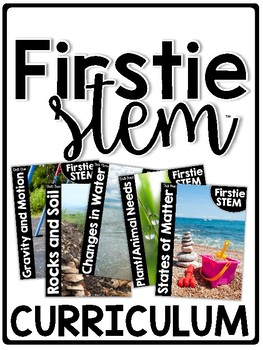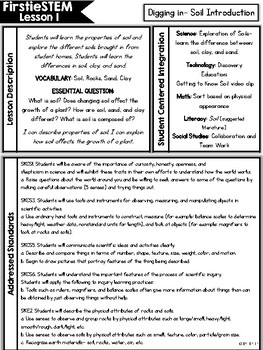Firstie/KinderSTEM First Grade STEM Curriculum Bundle
- Zip
What educators are saying
Description
Firstie/KinderSTEM Curriculum Bundle
Thanks so much for viewing my Firstie/KinderSTEM Curriculum units bundled. Firstie/KinderSTEM Curriculum is an engaging STEM curriculum with young learners in mind! Firstie/KinderSTEM is standards-based and encourages young learners to think “outside the box” and prove their thinking through hands-on and engaging learning experiences.
What is STEM?
STEM is the integration (not singular practice) of Science, Technology, Engineering, and Math in an active environment that focuses on student-centered learning. Students are engaged in discovering problems, questioning, problem solving, collaborating, and hands on activities while they face real world issues. Students are encouraged to approach the problem based upon their previous learning. Everyone’s voice matters, all ideas matter and are discussed and attempted. Students evaluate their approach and solution throughout the STEM activity and improve their design as they build and experiment. Teachers are facilitators of thinking and guide students through the problem solving experience.
What Units Are Included in Firstie/KinderSTEM
FirstieSTEM is based upon five units: Motion and Gravity, Rocks and Soil, Changes in Water, Plant/Animal Needs, and States of Matter. Each unit is broken down into five to seven lessons. ** However, please note that each lesson can take several academic days to complete. Each lesson has the standards covered, materials list, lesson vocabulary, STEM design loop integration, detailed activity lesson plans, and all necessary student recording sheets.
The units also includes “action” photos, vocabulary cards, parent unit overview letter, parent involvement request slips, STEM design loop, and all other necessary supplies. The lessons will at times suggest the integration of online book sources and online video databases to engage the learners into the unit topic. Please note that all student response sheets can be shrunk and placed into a student STEM journal. You can also choose to have students track their daily STEM activities in their STEM journal with or without the included response sheets.
Firstie/KinderSTEM is a Growing Bundle!
Unit One: Gravity and Motion INCLUDED
Unit Two: Rocks and Soil INCLUDED
Unit Three: Changes in Water INCLUDED
Unit Four: Plant and Animal Needs INCLUDED
Unit Five: States of Matter INCLUDED
Overview of Units:
Gravity and Motion- During this unit of study, the students will explore motion through understandings of the effects of push, pull, gravity, and force on objects. The student engineers will use the knowledge they gained from this unit to create ramps and tracks. Students will be presented with a problem, imagine the possibilities to create a structure, plan the resources they will use, and create a track together in a small group. By the end of this unit, students will understand the STEM design loop and will be able to communicate their understanding of the effects of motion and gravity on an object.
Rocks and Soil- During this unit of study, the students will explore rocks and soil through understandings of weathering, erosion, comparing, contrasting, sorting, using their senses to observe and building their understanding of how rocks and soil effect the world around them. The student engineers will use the knowledge they gained from this unit to create sifters to help sort rocks and soil.
Plant and Animal Needs- In this STEM unit, student will be learning all about the basic needs of plants and animals, will be able to identify plant parts, and will be able to compare and describe various animals. Students will create a habitat for a rainforest animal that will meet their basic needs based on classroom learning.
States of Matter- During this unit, the students will identify and experiment with the properties of solids, liquids, and gases. In addition, students will explore the various types of physical changes. The student engineers will use the knowledge they gained from this unit to create play dough.
Changes in Water- Students will identify and experiment with the water cycle, different stages of water (solid, liquid, gas) and weight of water before and after freezing. The student engineers will use the knowledge they have gained from this unit to create an icehouse. Once the icehouse is made from various materials, each team of engineers will test their icehouses to see if it slows the rate of ice melting compared the uncovered ice cube (constant). This design challenge will allow the students to investigate and demonstrate their understanding of the basic properties of frozen and liquid water
What About Standards?
The units are based upon commonly phrases state science standards as well as the Next Generation Science Standards! Within the units you'll see those commonly used phrases of science power standards across state to state. Below are additional NGSS!
Unit 1: K-PS2 Motion and Stability: Forces and interactions, K-2-ETS1 Engineering Design
Unit 2: K-PS3 Energy, K-2-ETS1 Engineering Design
Unit 3: K-ESS2 Earth’s Systems, K-2-ETS1 Engineering Design
Unit 4: K-LS1 From Molecules to Organisms: Structures and Processes, K-2-ETS1 Engineering Design
Unit 5: K-2-ETS1-2. Develop a simple sketch, drawing, or physical model to illustrate how the shape of an object helps it function
as needed to solve a given problem.
Why STEM is important?
According to the U.S. Department of Education, all STEM jobs in the U.S. will increase 14 percent from 2010-2020, accounting for millions of positions. Yet many will go unfilled, as students are not prepared for an occupation in this field. We can change this, we must change this.
Using a STEM approach in teaching allows students to apply learning that occurred in the four subject areas to a real life problem given by the teacher. Students are able to problem solve in a way that the typical classroom learning does not allow. STEM capitalizes on students’ interests and experiences, builds on what they know and have just learned, and provides them an opportunity to take chances and engage in learning in a different way. Using a STEM model prepares students to investigate questions they have about the world they live in and gives them the tools to solve daily problems they encounter. A STEM enriched classroom sounds different as well; students are conversing, sharing ideas, discussing possibilities, and using learned vocabulary as they experiment together.
As educators, our job is to teach, create compelling learning environments that foster learning for our students, and prepare them to be college, career, and life ready. The use of vocabulary, hands on approach, and collaboration that occurs during these STEM lessons amazes me as a teacher. Some of my students who struggle with reading or math facts excel in STEM lessons. Their confidence builds as their team listens to their ideas; they feel valued and a part of the learning in a way they never have before. These students find new interests, strengths, and set new goals for their future. I learn more about my students while observing them solve problems in a STEM setting than I do in any other situation in the classroom.
* * Be sure to view the preview for a look at the lesson plan set up!
What is the difference between KinderSTEM and FirstieSTEM?
Kinder and Firstie STEM units are similar in the topics and skills that are covered. You will not need both sets, only one!
Visit my blog Little Minds at Work
Follow me on Facebook





